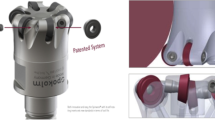Abstract
In this paper, two different turning processes namely rotational turning and hard turning are compared to each other regarding surface generation aspects. By experiments it is shown that, with higher feed rates, rotational turning yields same surface quality as hard turning. Feed rates can be chosen six times higher in rotational turning than in conventional hard turning without losses in the surface roughness quality. Also experiments reveal that the tool wear in rotational turning has a beneficial effect on the surface roughness. A corresponding explanation model is thereby presented which takes the specific tool/work piece engagement in rotational turning into account. Furthermore, it is shown that rotational turning has negative effects on the surface integrity. The phase transformation zones (“white layers”) are thicker in rotational turned parts than in hard turned parts. Also the level of tensile residual stress in rotational turning is higher than in hard turning. Both effects are probably caused by high thermal material loads in rotational turning due to increased friction. However, the results of this paper show that rotational turning has a high potential to become an efficient alternative to hard turning, especially when it comes to large scale production of simple shaped parts.









Similar content being viewed by others
Abbreviations
- agr :
-
Depth of grooves
- ap :
-
Depth of cut
- f:
-
Feed
- r:
-
Radius
- rvirt :
-
Virtual tool corner radius in rotational turning
- rε :
-
Tool corner radius
- Ra:
-
Average roughness
- Rkin :
-
Kinematic roughness
- RSm:
-
Average groove width
- Rt :
-
Theoretical roughness
- Rz:
-
Average roughness depth
- n1 :
-
Work piece revolution
- n2 :
-
Tool revolution
- vc :
-
Cutting speed
- VB:
-
Width of flank wear
- λ:
-
Helix angle
- λc :
-
Cut-off length
References
Guo YB, Warren AW (2008) The impact of surface integrity by hard turning vs. grinding on fatigue damage mechanisms in rolling contact. Surf Coat Technol 203:291–299. doi:10.1016/j.surfcoat.2008.09.005
Stier H (1989) Cubic boron nitride to turn heat treated steel (column). Mod Mach Shop 4:1989
Denkena B, Boehnke D, Meyer R (2008) Reduction of wear induced surface zone effects during hard turning by means of new tool geometries. Prod Eng Res Dev 2:123–132. doi:10.1007/s11740-008-0089-1
Brandt D (1995) Randzonenbeeinflussung beim hartdrehen. VDI, Duesseldorf
Bartarya G, Choudhury SK (2012) State of the art in hard turning. Int J Mach Tools Manuf 53:1–14. doi:10.1016/j.ijmachtools.2011.08.019
Jochmann S (2001) Untersuchungen zu Prozess- und Werkzeugauslegung beim Hochpräzisionshartdrehen. Shaker, Aachen
Kummer N (2004) Verfahren und Vorrichtung zum spanenden Bearbeiten rotationssymmetrischer Flächen eines Werkstücks. Patent DE102004026675C5
Klocke F, Bergs T, Degen F, Ganser P (2013) Presentation of a novel cutting technology for precision machining of hardened, rotationally symmetric parts. Prod Eng Res Dev 7:177–184. doi:10.1007/s11740-012-0438-y
Deutsches Institut für Normung e.V. (1998) Geometrical product specifications (GPS)—surface texture: profile method—terms, definitions and surface texture parameters. DIN EN ISO 4287
Deutsches Institut für Normung e.V. (1998) Geometrical product specifications (GPS)—surface texture: profile method—rules and procedures for the assessment of surface texture. DIN EN ISO 4288
Pavel R, Marinescu I, Deis M, Pillar J (2005) Effect of tool wear on surface finish for a case of continuous and interrupted hard turning. J Mater Process Technol 170:341–349. doi:10.1016/j.jmatprotec.2005.04.119
Ramesh A, Melkote SN, Allard LF, Riester L, Watkins TR (2005) Analysis of white layers formed in hard turning of AISI 52100 steel. Mater Sci Eng A390:88–97
Tomlinson WJ, Blunt LA, Spraggett S (1989) White layers on surface of ground EN24 steel—microstructure, composition, internal stress, and corrosion properties. Surf Eng 5(3):229–233
Shaw MC, Vyas A (1994) Heat-affected zones in grinding steel. Ann CIRP 43(1):279–282
Snoeys R, Leuven K, Maris M, Peters J (1978) Thermally induced damage in grinding. Ann CIRP 27:571–581
Klocke F, Brinksmeier E, Weinert E (2005) Capability profile of hard cutting and grinding processes. Ann CIRP 54(2):22–45
Smith S, Melkote SN, Curzio L, Watkins ET, Allard R, Riester L (2007) Effect of surface integrity of hard turned AISI 52100 steel on fatigue performance. Mater Sci Eng A459:337–346
Guo YB, Schwach DW (2005) An experimental investigation of white layer on rolling contact fatigue using acoustic emission technique. Int J Fatigue 27:1051–1061
Chou YK, Evans CJ (1999) White layers and thermal modelling of hard turned surfaces. Int J Mach Tools Manuf 39:1863–1881
Liermann J (1998) Hartdrehen wälzbelasteter oberflächen. Shaker, Aachen
Gunnberg F, Escursell M, Jacobson M (2006) The influence of cutting parameters on residual stresses and surface topography during hard turning of 18MnCr5 case carburised steel. J Mater Process Technol 174:82–90. doi:10.1016/j.jmatprotec.2005.02.262
Dahlman P, Gunnberg F, Jacobson M (2003) The influence of rake angle, cutting feed and cutting depth on residual stresses in hard turning. J Mater Process Technol 147:181–184
Hua J, Shivpuria R, Cheng X, Bedekar V, Matsumoto Y, Hashimoto F, Watkins TR (2004) Effect of feed rate, workpiece hardness and cutting edge on subsurface residual stress in the hard turning of bearing steel using chamfer + hone cutting edge geometry. Mater Sci Eng A394:238–248
Tönshoff HK, Arendt C, Armor AB (2000) Cutting of hardened steel. Ann CIRP 46(2):547–566
Röttger K (2003) Walzen hartgedrehter Oberflächen. Shaker, Aachen
Brinksmeier E, Garbrecht M, Meyer D, Dong J (2007) Surface hardening by strain induced martensitic transformation. Prod Eng Res Dev 2:109–116
Nowag L, Sölter J, Brinksmeier E (2007) Influence of turning parameters on distortion of bearing rings. Prod Eng Res Dev 1:135–139. doi:10.1007/s11740-007-0009-9
Kohlhoff T, Sölter J, Brinksmeier E (2011) Influence of the turning process on the distortion of disks for gear manufacture. Prod Eng Res Dev 5:613–620. doi:10.1007/s11740-011-0336-8
Author information
Authors and Affiliations
Corresponding author
Rights and permissions
About this article
Cite this article
Degen, F., Klocke, F., Bergs, T. et al. Comparison of rotational turning and hard turning regarding surface generation. Prod. Eng. Res. Devel. 8, 309–317 (2014). https://doi.org/10.1007/s11740-014-0530-6
Received:
Accepted:
Published:
Issue Date:
DOI: https://doi.org/10.1007/s11740-014-0530-6



